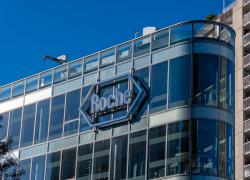
Triple meeting 2024 – Zai Lab impresses in small cell
ZL-1310 looks better than other DLL3-targeting agents, but two thirds of responses are so far unconfirmed.
ZL-1310 looks better than other DLL3-targeting agents, but two thirds of responses are so far unconfirmed.

DLL3 is back in vogue as a target, and Zai Lab just unveiled data that appear to trump the only approved therapy, Amgen’s T-cell engager Imdelltra. Zai Lab’s ADC ZL-1310 produced an ORR of 74%, according to phase 1 results presented at the Triple meeting on Thursday – which stacks up well against the 40% that supported Imdelltra’s US accelerated green light.
However, a closer look shows that nearly two thirds of the responses with ZL-1310 were unconfirmed, and the ORR sinks to a much less impressive 26% if only confirmed responses are counted.
74% or 26%
The phase 1 study, in second-line or later small-cell lung cancer not preselected for DLL3 expression, initially tested ZL-1310 monotherapy at 0.8mg/kg 1.6mg/kg, 2.0mg/kg and 2.4mg/kg. Among 19 evaluable patients there were 14 partial responses, Zai Lab said today.
However, the presentation at the Triple (EORTC-NCI-AACR) symposium showed that only five of these had been confirmed.
There’s still hope that ZL-1310 could outdo Imdelltra, as well as Merck & Co/Daiichi’s T-cell engager MK-6070: it seems that confirmed ORR could improve, with the nine unconfirmed responses ongoing at the 10 October cutoff date.
And, interestingly, there was a partial response in one patient who previously received Imdelltra and went on to get ZL-1310. Zai Lab shares traded up 15% on Thursday.
Cross-trial comparison of DLL3-targeting agents in SCLC
| Project | ZL-1310 | Imdelltra | MK-6070 |
|---|---|---|---|
| Company | Zai Lab | Amgen | Merck & Co (via Harpoon)/ Daiichi |
| Description | ADC | T-cell engager | T-cell engager |
| Trial | Global ph1 | Ph2 Dellphi-301** | US ph1/2 in solid tumours |
| Setting | 2nd-line plus | 3rd-line plus | 2nd-line plus |
| Presentation venue | Triple meeting 2024 | ESMO 2023 | ASCO 2024 |
| ORR | 74% (14/19)* | 40% (40/99) | 39% (11/28)^ |
| Gr≥3 TRAEs | 20% | 26% | 26%^^ |
| Discontinuations | 0% | 3% | 4%^^ |
Note: all trials uncontrolled; *includes unconfirmed responses; **efficacy & safety data for 10mg (approved) dose only; ^SCLC pts only; ^^across all cohorts. Source: OncologyPipeline & Imdelltra label.
It’s also worth noting that the latest results with ZL-1310 come across all dose-escalation cohorts, so the response rate could improve further once the go-forward dose(s) are selected. Zai Lab also plans to test the project in combination with Roche’s PD-L1 blocker Tecentriq.
As for safety, ZL-1310 looks slightly better than both Imdelltra and MK-6070, with the caveat of low patient numbers. 20% of patients receiving ZL-1310 had grade 3 or higher treatment-related adverse events, with neutropenia most common. There were no treatment-emergent discontinuations or deaths. There was one dose-limiting toxicity of grade 4 transient neutropenia/thrombocytopenia in the 2.4mg/kg cohort.
Combos
Another SCLC contender is Merck & Daiichi’s B7-H3-targeting ADC ifinatamab deruxtecan, which recently produced an ORR of 55% in the high-dose cohort of the phase 2 Ideate-Lung01 trial. The companies are now testing a combination of MK-6070 with ifinatamab-dxd in phase 1/2.
Amgen also plans to evaluate Imdelltra alongside MediLink’s B7-H3-targeting ADC YL201. One question is whether such combinations could improve efficacy while avoiding unacceptable toxicity.
Options could soon be increasing for SCLC, which was for a long time a poorly served cancer. Still, ZL-1310 is one of only three clinical-stage DLL3-targeted ADCs, according to OncologyPipeline, the others being Systimmune’s BL-M14D1 and Shanghai Fudan-Zhangjiang's FZ-AD005 (both in phase 1 in China).
ADCs, and DLL3 in general, fell out of favour when AbbVie discontinued rova-T after failing to find a therapeutic window. The latest results support the idea that it was the poor design of rova-T that was the problem, although Zai Lab will have to prove this in more patients.
1558













